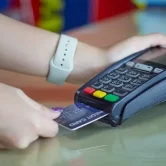3 Niche Ways to Wear Payments
Regardless of whether you think contactless payments are a fad, there is no dispute they are clearly here to stay. Wearables aren’t just for showing smartphone notifications and tracking your fitness (or lack of it); a growing number of them are adding contactless payments to the mix.
Technology companies have been developing products and software geared towards wearable gadgets, and it now appears apparent that this will be the natural progression to incorporating a payment platform.
For all of the positive, there has been no denying there has also been wearable technology disasters. Rewind back to 1990, and Nintendo launched the Powerglove for the NES home system which was the first video game controller that allowed players to operate NES games with intuitive hand gestures. Despite immense hype surrounding its release, it was panned by critics and discontinued.
Fossil wrist watch – In 2002 US watch maker Fossil was an early entrant into the smart watch race – so early, in fact, that it didn’t have anyone to race against, and no one understood the rules of the race anyway. Its wrist PDA ran the same Palm OS that powered more fully-fledged pocketable computers, and Fossil had to completely rewrite its code to run on such a (then) tiny device. Disappointing sales led to Fossil discontinuing this admirable failure three years later.
A lot of the developments have all been made possible by an NFC (Near Field Communication) chip. What is NFC? It is a set of communication protocols that enable two electronic devices, one of which is usually a portable device such as a smartphone, to establish communication. This is the same microchip you’ll find planted in a contactless debit or credit card or smartphone. When it’s brought into physical contact (around 4 cm) with another NFC-enabled device, like a contactless card terminal, a set of protocols are followed. In this case, taking payments. We are going to look at three examples of wearable technology.
1). The Temporary Tattoo
Chaotic Moon, an American based technology design company, is experimenting with conductive paint and electronic components, including LED lights, to build skin-mounted gadgets that could be used to monitor vital signs or hold debit and credit card information.
The product which has often been referred to as ‘Tech Tats,’ is a simple stick on and wash off design like a temporary tattoo. The one advantage of this, means they’d be relatively cheap and will appeal to many. The devices are still in development, but the company told Techcrunch that it’s in talks with several groups to market them.
2). The Ring
There are quite a few dedicated NFC rings available and the market seems to be growing rapidly. The Kerv NFC smart ring allows you to make payments, validate you on public transport and unlock smart locks. Thus far, there aren’t any alerts or fitness tracking – Kerv is focused on just a few key features – payments and ID, and based on this it will appeal to many. It has been praised for keeping things simple. It’s still very days for the Kerv, but initial feedback has been extremely positive. The item is now available in seven colours, and it’s been deemed as an affordable piece of smart jewellery – for men and women.
3). The Watch
We’ve seen plenty of additions to the market in 2016 including Microsoft Band 2 and Samsung Gear S2 amongst others, and the popularity is continuing to rise with the most popular of all being the Apple Watch. The Apple Watch will let you pay for stuff. Thanks to Apple Pay, which went live in July 2015 (to much acclaim), it is a portable payment device as well as a smart timepiece. Your iPhone handles the job of adding credit and debit cards, as well as verifying your identity, and you can then pay using the Apple Watch with a flick of your wrist.
Significant growth of NFC payments systems
The growth of wearable payment technologies will continue to rise in 2017 and beyond. Payment technologies will move beyond smartwatches. NFC technology can be affixed on anything wearable.
The biggest advantage of this expansion will be convenience. Right now, having your smartphone with you is necessary to enjoy contactless payments. With wearables, you can access your money from your smartwatch, glasses, necklace or anything else NFC-enabled you have on you. Let us know your thoughts on where you see it going.





